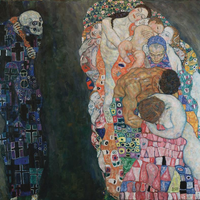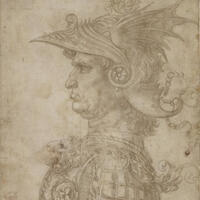More about Marsden Hartley
- All
- Info
- Shop

Contributor
Fellow artist Alfred Dreymborg once said of Marsden Hartley, "When spring came, if he could afford nothing else, Marsden managed to buy a gardenia for his buttonhole."
Apart from his effortlessly cool style, Marsden had all the makings of a scrappy all-american artist. Born Edmund Hartley, after finishing art school he re-invented himself and took the maiden name of his step-mother as his new first name. Hartley’s melancholy still-life paintings and landscapes of his home state of Maine reflect a loneliness stemming from the death of his mother when Hartley was only 8. He later declared about that time, “I was to know complete isolation from that moment forward."
Steeping himself in the nature of Maine and the literature of Thoreau and Emerson, Hartley found inspiration for his art. Even so, loneliness followed Hartley when he ventured to Paris to hang out with Gertrude Stein and her crew of artists. He wasn’t happy until he moved to Berlin, where he would produce his most important works. His "War Series" was the fruit of Hartley’s love affair with the Germany, and coincided with deep personal exploration. Hartley was impressed by Berlin, proclaiming that it was the first modern city in Europe (a slight F-you to Paris). Hartley embodied his whole, unique, gardenia-in-butthole self in Berlin and wrote his friend that he was “living gayly in Berlin - with all that implies”. Scholars know that Hartley was in love with a German soldier, Karl von Freyburg, although they are not sure if the feelings were mutual. Von Freyburg’s WWI death and Hartley’s corresponding heartbreak is reflected in various symbols in "War Series." Harley’s coming of age in Berlin inspired him to travel, with stays in places like Mexico and Bermuda, alternating with trips back to his beloved Germany and the United States. Towards the end of his life, Hartley moved away from his European-inspired abstraction and gravitated back to landscapes, as well as portraits that seemed to embrace his sexuality. He died broke after a long battle with health issues, but by playing with the artistic movements of the era, he managed to create an innovative personal style that is emblematic of American art.
Sources
- "Marsden Hartley's Life and Legacy." The Art Story. Accessed August 31, 2018. https://www.theartstory.org/artist-hartley-marsden-life-and-legacy.htm#…
- Mcdonnell, Patricia. "Marsden Hartleys Letters to Franz Marc and Wassily Kandinsky 1913-1914." Archives of American Art Journal29, no. 1/2 (1989): 35-44. doi:10.1086/aaa.29.1_2.1557588
- Mcdonnell, Patricia. ""Essentially Masculine": Marsden Hartley, Gay Identity, and the Wilhelmine German Military." Art Journal56, no. 2 (1997): 62. doi:10.2307/777680
- Smith, Roberta. "Marsden Hartley Gets His Due in Berlin." The New York Times. June 12, 2014. Accessed August 31, 2018. https://www.nytimes.com/2014/06/15/arts/design/marsden-hartley-gets-his….

Contributor
For Marsden Hartley, growing up quickly was an inevitability and his journey as an artist would bring him around the world.
To begin with, Hartley was born in Maine as one of eight children. Then, when he was only eight, his mother died. His father, who was working in a cotton mill, remarried and relocated the entire family to Cleveland with their new mother.
It was in Cleveland that Hartley began to study art. But he had to pay the price in order to do so. His father essentially abandoned him, leaving him to work in a shoe factory at the age of 15. At 15 I was working the ride “Funtown Fire Academy” at Legoland, so I don’t feel that bad for him - just saying.
Luckily Hartley escaped the shoe factory quickly, and discovered he really was a talented artist. He began attending art school in Cleveland before he moved to New York in 1899 to continue his painting. In New York, he met and befriended the Greenwich Village artist circle - people like William Carlos Williams, Gertrude Stein, and Hart Crane. New York really does change people. By 1912, he had changed his first name from Edmund to Marsden (in honor of his deceased mother’s maiden name) and moved to Paris.
Hartley moved from Paris in 1912 to Berlin in 1913, and he fell completely in love with Berlin. The city was in the midst of an incredibly lively and liberal phase in terms of culture and sexuality. It was in Berlin that Hartley fell in love with a German lieutenant named Karl von Freyburg. Little is known of von Freyburg aside from the fact that he is tall and blonde. Hartley, on the other hand, was described as magnificently large and strange looking. The New Yorker’s art critic, Peter Schjeldahl, describes him best, saying, “Hartley was fabulously ugly, in an Abraham Lincoln way; a big man, he had a long face that joined a high dome, deep-set eyes under sloping brows, a huge nose, and, over all, the look of an extraordinarily intelligent hound dog.” They must have been an extremely noticeable pair roaming the streets of Berlin together.
It was during this intensely nationalistic period in Germany that Hartley would paint some of his most famous pieces. He bought into the rampant German nationalism of the time, and he frequently attended military parades. He commented on the German military saying, “It stimulates my child’s love for the public spectacle — and such wonderful specimens of health these men are — thousands all so blond and radiant.” His Cubist paintings were strongly influenced by German artists like Wassily Kandinsky and Franz Marc. When von Freyburg died, Hartley painted fourteen pieces all inspired by the German army and von Freyburg.
But when the war heightened in intensity in 1915, Hartley had no choice but to return to New York City. Because of his obvious references to the German military in his work, Hartley was received dismissively in the United States. Perhaps because of his cold reception, Hartley began to meander, taking frequent trips to places like inland Massachusetts and Mexico before settling back in Maine for the end of his career. In Maine, Hartley began to paint sexualized, serious-looking fisherman and athletes, which are now considered some of his best works, along with those questionable German military paintings.
Sources
- Lyon, Christopher. "Marsden Hartley's Maine: His Own Private Germany." Hyperallergic. April 21, 2017. Accessed August 23, 2018. https://hyperallergic.com/373647/marsden-hartleys-maine-his-own-private….
- Messerli, Douglas. "On the Outside Looking In: Mardsen Hartley's Poetry." Hyperallergic. January 28, 2016. Accessed August 23, 2018. https://hyperallergic.com/269667/on-the-outside-looking-in-mardsen-hart….
- Schjeldahl, Peter. "The Searcher." The New Yorker. June 20, 2017. Accessed August 22, 2018. https://www.newyorker.com/magazine/2003/02/03/the-searcher-2.
- Smith, Roberta. "ART REVIEW; Marsden Hartley's World: A Body Electric." The New York Times. January 31, 2003. Accessed August 23, 2018. https://www.nytimes.com/2003/01/31/arts/art-review-marsden-hartley-s-wo….
Featured Content
Here is what Wikipedia says about Marsden Hartley
Marsden Hartley (January 4, 1877 – September 2, 1943) was an American Modernist painter, poet, and essayist. Hartley developed his painting abilities by observing Cubist artists in Paris and Berlin.
Check out the full Wikipedia article about Marsden Hartley




















